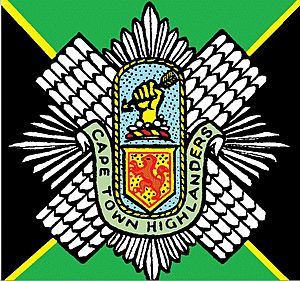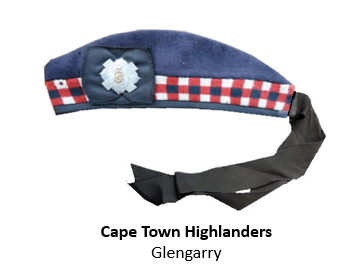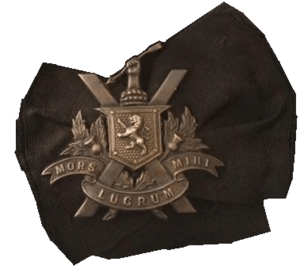Cape Town Highlanders facts for kids
Quick facts for kids Cape Town HighlandersDuke of Connaught and Strathearn's Own Cape Town Highlanders Queen's Own Cape Town Highlanders |
|
|---|---|

SANDF Cape Town Highlanders regimental emblem
|
|
| Founded | 24 April 1885 |
| Country | |
| Branch | |
| Type | Infantry |
| Role | Mechanised infantry |
| Size | One battalion |
| Part of | South African Infantry Formation Army Conventional Reserve |
| Garrison/HQ | Castle Barracks, Cape Town, South Africa |
| Motto(s) |
|
| March | Quick: Cock o' the North |
| Anniversaries | 24 April (Regimental Day) |
| Commanders | |
| Colonel of the Regiment | Colonel P. McLoughlin PVD, SM, MMM |
| Insignia | |
| Abbreviation | CTH |
| Tartan | Gordon |
| Company level Insignia |  |
| SA Mechanised Infantry beret bar circa 1992 | |
The Cape Town Highlanders is a special army group in South Africa. It is a mechanised infantry regiment, which means its soldiers use armoured vehicles to move around and fight. This group is part of the South African Army's reserve forces.
Contents
History of the Highlanders
How it Started
The Cape Town Highlanders started in 1885. It was formed by people in South Africa who had Scottish backgrounds. On April 24, 1885, their offer to serve was accepted. This date is now celebrated as the regiment's birthday every year.
Early Missions
The regiment first saw action in the Bechuanaland Campaign. This fight happened in the Northern Cape region between 1896 and 1897.
Later, when the Second Anglo-Boer War began, the regiment was called to duty again. They took part in several important events, including helping to free the town of Kimberley from a siege.
Changes Over Time
In 1906, Prince Arthur, Duke of Connaught and Strathearn became a special leader for the regiment. Because of this, the regiment's name changed to the Duke of Connaught and Strathearn's Own Cape Town Highlanders.
When the regiment joined the Union Defence Force (UDF) in 1913, its name changed again. It became the 6th Infantry (Duke of Connaught and Strathearn's Own Cape Town Highlanders).
World War I
During World War I, the Cape Town Highlanders first fought against Germany in German South-West Africa. Later, they joined with another Scottish unit to form the 4th South African Infantry (South African Scottish) Regiment. This new group was part of the 1st South African Brigade.
This brigade fought in North Africa during the Senussi Campaign. After that, they went to France. There, they took part in many big battles between 1916 and 1918. One of the most famous was the Battle of Delville Wood.
In 1932, the regiment's name changed once more. It became the Cape Town Highlanders (Duke of Connaught and Strathearn's Own).
World War II
The regiment was called up again when World War II started in 1939. They were sent to Egypt in 1941 to guard Italian prisoners of war. Later that year, they returned to Egypt to join the South African 1st Infantry Division.
The Cape Town Highlanders fought in all the main battles in the Western Desert campaign. This included the famous Battle of El Alamein. They are one of only three regiments in the world to have three special honours from Alamein.
Later, the regiment went to Italy. There, they joined with another unit to form the First City/Cape Town Highlanders. This combined unit fought from Battle of Monte Cassino all the way to the Alps. They bravely captured a key mountain called Monte Sole.
In 1947, Queen Elizabeth (who later became the Queen Mother) became a special leader for the regiment. From 1948 until South Africa became a republic in 1961, the regiment was known as the Queen's Own Cape Town Highlanders.
Later Years
Border War
After World War II, the Cape Town Highlanders were involved in Operation Savannah in January 1976. This was a large operation by the South African Defence Force (SADF) in Angola. Over the next few years, the regiment was called to duty many times. Their last mission during this period was in October 1988.
Modern Day Role
In April 1994, the regiment helped ensure a peaceful first democratic election in South Africa. Today, the Cape Town Highlanders Regiment is a volunteer group. This means people choose to join them.
Since 2000, the regiment's Pipes and Drums band has performed at many famous events. These include the Edinburgh Military Tattoo and the Basel Tattoo. They even performed for the Royal Family at Balmoral Castle in 2006.
Name Discussion
In 2019, there was a plan to change the names of many South African Army Reserve units. The Cape Town Highlanders was going to be called the Gonnema Regiment. However, in 2022, it was confirmed that the unit's name has not officially changed. It is still known as the Cape Town Highlanders.
What the Regiment Does Now
The Cape Town Highlanders is a mechanised infantry regiment in the SANDF. Its members have helped with peacekeeping missions in the Democratic Republic of the Congo and Burundi. They also help the police and protect South Africa's borders.
In April 2015, the regiment celebrated its 130th birthday. They had special dinners and parades in Cape Town.
Regimental Symbols
- Regimental tartan: The regiment wears the Gordon tartan. This is a special pattern of fabric from the Scottish Gordon clan. It is the only regiment in the world that wears a kilt in this specific tartan.
- Regimental mottos: The regiment has two mottos. The first is "Nemo Me Impune Lacessit" in Latin. It means "No One Assails Me with Impunity". The second motto is "Bydand", which means "Steadfast" in a Scottish dialect.
- Regimental quick march: The regiment's quick march is "Cock o' the North". This song remembers a famous Scottish leader.
Dress Insignia
During World War I, a special unit called the South African Scottish was formed. It combined soldiers from the Transvaal Scottish and the Cape Town Highlanders. Their badges were similar to the Cape Town Highlanders' but had a different Latin motto.
Customs and Traditions
The unit wears black boots instead of brown. This is a sign of mourning for a Scottish soldier named Major-General Sir John Moore.
They wear two types of hats: the khaki Balmoral bonnet and the blue Glengarry with red and white checks. The Balmoral is for daily wear, while the Glengarry is for special events and evenings.
Officers carry a walking stick made from an ash-plant. Non-commissioned officers (NCOs) carry a "swagger stick". These are signs of their important roles.
A special rule is that no officer or NCO can eat before their soldiers have eaten.
Alliances
The Cape Town Highlanders have special connections with other military units:
 United Kingdom – The Highlanders (from the UK)
United Kingdom – The Highlanders (from the UK) Australia – The Royal Victoria Regiment (from Australia)
Australia – The Royal Victoria Regiment (from Australia)
Battle Honours
Awards Received
The Cape Town Highlanders Regiment has many battle honours displayed on its flags. These include: Bechuanaland 1896–97, *South Africa 1899–1902, South West Africa 1915, Gazala, Alem Hamza, Best Post, Alamein Box, Alamein Defence, Alem el Halfa, Battle of El Alamein, Western Desert 1941–43, Cassino II, Paliano, Chiusi, Florence, Gothic Line, The Greve, Monte Stanco, Monte Pezza, Sole/Caprara, Po Valley, Italy 1944–45.
The "Lost" Honours
During World War I, South African troops were not allowed to fight far from home. So, a special "Imperial Unit" was created to send soldiers to Europe. Because of this, some battle honours awarded to the 4th South African Infantry (South African Scottish) battalion were not officially kept by the regiment after the war.
These "missing" battle honours include some very famous ones from France and Flanders: Egypt 1916, Somme 1916, Delville Wood, Arras 1917, Ypres 1917, Menin Road, Messines 1918, Hindenburg Line, Cambrai 1918, Pursuit to Mons, France and Flanders 1918, Le Transloy, Scarpe 1917, Kemmel, Lys.
Leadership
The Cape Town Highlanders has had many important leaders throughout its history. Here are some of the key roles and their current or most recent holders:
- Colonel-In-Chief: This is a special honorary leader.
- Queen Elizabeth the Queen Mother (1947-1961)
- Honorary Colonel: Another honorary role.
- Vice-Admiral J. Johnson (from 1984)
- Colonel of the Regiment: A senior leader.
- Col (Hon) P. McLoughlin (Current)
- Commanding Officer: The main leader of the regiment.
- Lt Col. Stephan Pierce (Current, from 2019)
- Regimental Sergeant Major: The most senior non-commissioned officer.
- MWO Daantjie Prins (Current, from 2021)




